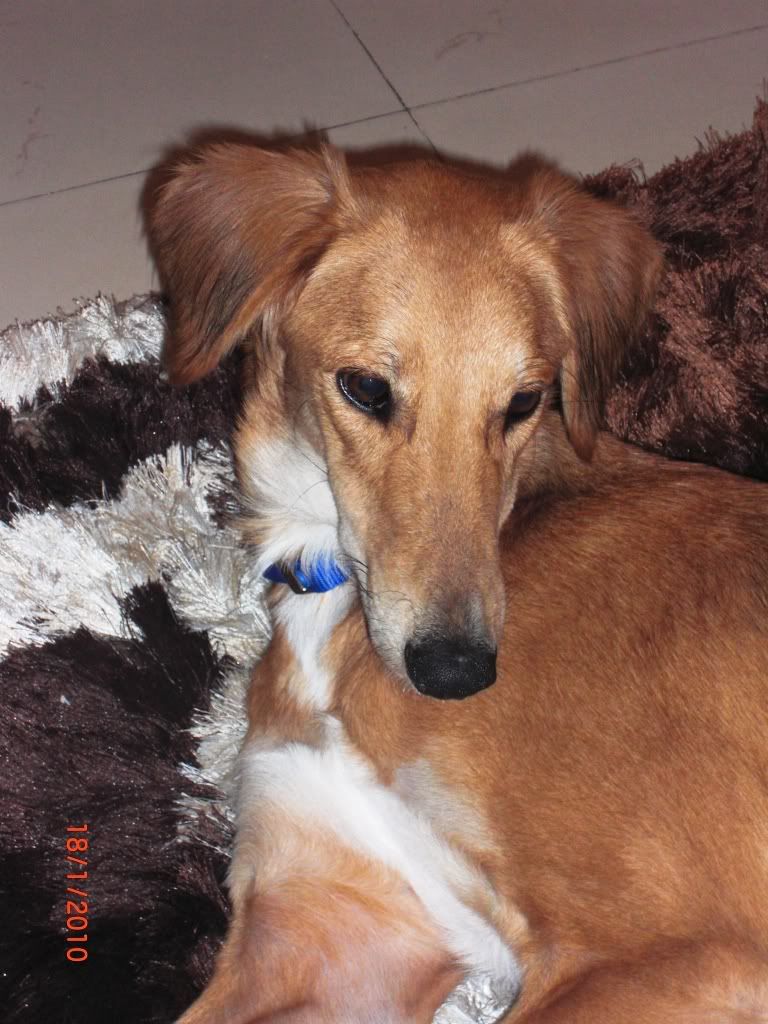Canine hip dysplasia is a medical condition commonly found in dogs, particularly large body mass breeds. Doctor Karen Becker states "It is is a polygenetic multi-factorial disease, which means there is a genetic component, more than one gene is involved, and it is caused by a number of factors, some of which have yet to be identified." Dog wellness brings to your attention the very important factors on how to prevent this disease from developing in your dog.
CHD is when the ball and socket hip joint is malformed, causing separation of the two bones of the joint. The socket is not formed properly to fit the ball completely in place. This less-than-perfect fit causes the bones to separate, resulting in abnormal joint structure along with weak muscles, ligaments and connective tissue that support the joints. The result is chafing and grinding joints.
The dog's body will try to compensate for the poor joint fit by producing a hard bony material around the in and around - attempting to stabilize the problem. Unfortunately this alteration has the opposite effect by creating an even worse fit of the joint.
Eventually the wear on the joint from the chafing and grinding results in degenerative joint disease (DJD), which is a painful, debilitating disease that will take your dog down fast.
CHD develops between five and twelve months of age for the severe form of the disease; later for the chronic form.
CHD Testing
Without the gene a dog will not acquire CHD, however if he does have the gene he is likely to develop it but he is also likely not to develop it - so dog wellness preventative measures is highly necessary in order to give your dog a fighting chance of not developing the disease.
With certain breeds of dogs, like the German Shepard, puppies are often tested at a young age in order to rule out any hip problems. The family history of the puppy is also taken into consideration. However, even if prior generations show no signs of CHD, their puppies are still at risk. Even if a dog shows high OFA and PennHIP scores, they can still carry the genes of the disease. Currently, there is no test that can identify if the dog is a gene carrier.
The hip is the biggest joint in your dog’s body and bares the majority of his weight during any kind of movement. That’s why hip dysplasia can be such a painful, debilitating disease, especially as it is predominantly seen in large breed dogs with heavy body mass.
Symptoms and Diagnosis of Canine Hip Dysplasia
A dog with CHD may have one or a combination of the following symptoms:
- Abnormal gait
- Bunny-hopping when running
- Thigh muscle atrophy (loss of muscle mass)
- Pain
- Low exercise tolerance
- Reluctance to climb stairs
- Audible "click" when walking
- Increased width between points of the hips
Diagnosis is typically made either because a dog is showing symptoms, or as the result of a standard hip exam prior to breeding a purebred dog.
The vet will perform a complete physical exam and take x-rays. Joint problems are easily seen on x-rays of dogs exhibiting symptoms. The vet may also be able to feel looseness in your dog’s hip joint, and note pain when a rear leg is extended or flexed.
Traditional Treatment of Hip Dysplasia
If hip laxity (looseness) is caught very early prior to any joint damage occurring, there are surgical procedures that can correct the joint malformation.
If your dog has already suffered degenerative joint disease from chronic hip dysplasia, surgical options are either a total hip replacement or a procedure in which the head of the femur is removed and a ‘fake’ hip joint replaces it. This option is less costly than a full hip replacement, but is most successful in dogs weighing less than 40 pounds.
The cost of a surgery such as this is extremely costly and usually not affordable to most dog owners, so the best bet is to ensure dog owners put dog wellness strategies into place and look at preventative measures for CHD. Particularly if you have a large breed dog.
Pain Management for CHD
Pain management involves the use of non-steroidal anti-inflammatory drugs (NSAIDs), buffered aspirin and corticosteroids to alleviate inflammation and pain. The side effects of these drugs can include organ problems and gastric ulcers.
Complementary Therapies
In the event a dog is on pain medication for CHD it is highly recommended that the dog owner works with a holistic vet in order to find alternative treatements and pain mangement. This helps protect the dog's owner from Big Pharma pro vets that will use your dogs unfortunate situation to make more money by recommending medications the dog doesn't really need, and basically from ripping off pet owners. Utilizing alternative measures will also help protect your dog from the side effects caused by NSAIDs\ and other pain medications, that we know are toxic.
Doctor Karen Becker says in her opinion, the most important aspect of managing this debilitating disease is building and maintaining excellent muscle, tendon and ligament health through physical therapy, an anti-inflammatory diet and oral chondroprotective/supportive supplements.
Complementary therapies include:
-Chiropractic treatments. Chiropractic therapy can help your pet avoid the compensating injuries that often result from CHD.
-Massage. Regular massages can alleviate inflammation and prevent further damage through compensation.
-Stretching and other forms of physical therapy will increase the condition and mobility of her joints, tendons and ligaments, helping to preserve her range of motion.
-Low-level laser therapy can facilitate long lasting pain relief by stimulating the release of your dog’s own pain killing endorphins.
-Acupuncture can be tremendously beneficial in relieving the pain and inflammation of degenerative joint disease.
-Aquatic therapy, also known as hydrotherapy, uses an underwater treadmill or heated pool to take pressure off your dog’s injured or painful joints. Water therapy can also improve your dog’s cardiovascular health, muscle strength and range of motion critical for supporting dysplastic dogs.
-Adding certain supplements to your pet’s naturally anti-inflammatory diet can provide the raw materials for cartilage repair and maintenance, among them:
1. Glucosamine sulfate with MSM, Eggshell Membrane, Perna Mussel
2. Homeopathic remedies, including Rhus Tox
3. Ubiquinol and other antioxidants
4. Super green foods (Spirulina and Asthaxanin)
5. Natural anti-inflammatory formulas (herbs, proteolytic enzymes and nutraceuticals)
6. Adequan injections, which can stimulate joint fluid very rapidly in pets with arthritis
Dog Wellness Strategies for Prevention of Canine Hip Dysplasia
1. Selective breeding. More hip testing and more careful breeding can go a long way toward limiting the inheritance of CHD.
2. If you’re planning to get a purebred large-breed puppy, find breeders who PennHIP certify their dogs. OFA certification is still the established standard, but PennHIP is a much better indication of hip health. If greater numbers of potential dog owners demand PennHIP certification, more breeders will understand the importance of this test for their animals.
Unfortunately, PennHIP testing is more expensive and not as widely done as OFA, but it is highly preferable to the OFA method. The procedure can be done on dogs as young as 16 weeks. PennHIP uses a network of trained veterinarians and anesthesia is required rather than an option.
3. Slow weight gain in large-breed puppies. When a puppy gains size and weight too quickly, the cartilage in his body often can’t keep up with the growth of his frame, and cartilage deficits result. When imbalances of this type develop in a growing dog, they can contribute to hip dysplasia and osteoarthritis.
4.High calorie diets, which are typically also high in carbohydrates, can cause too-rapid growth, especially in larger breed dogs. In fact, research indicates the amount of calories a dog consumes, especially from the age of three to ten months, can have a significant impact on whether a pup genetically prone to hip dysplasia will develop the condition.
Despite what you might hear from other owners of large breed dogs or even from your vet, it is not protein in the diet that is linked to hip dysplasia, but calcium-phosphorus ratios and high caloric content. A portion-controlled, balanced, species-appropriate diet will provide your dog, no matter his age, with the right nutrition in the right amounts.
5. Obesity can increase the severity of dysplasia. Extra weight can accelerate the degeneration of joints. Dogs born with genes that make them prone to hip dysplasia, if allowed to grow overweight, will be at much higher risk of developing the disease, and subsequently, arthritis as well.
6. Appropriate exercise. There is evidence over-exercising large breed dogs at a young age may be a risk factor for dysplasia. Activities that require your dog to jump and land can apply a great deal of force to his joints.
However, moderate exercise such as running and especially swimming, will help your dog maintain good muscle mass, which has been shown to decrease the incidence and severity of the CHD. Your dog should get at least 20 minutes of sustained, heart-thumping exercise three times a week. However, the more moderate exercise he gets the better. Large breed dogs should be exercised daily for a full impact.
A reminder of how important strong dog wellness practices can be for dog owners and their dog is to remember that prevention can save money, pain, and a dog's life. The introduction of a raw natural diet and utilizing natural pet health care whenever possible is a recommendation that should not go ignored. Pay close attention to the breed, size and needs of the dog you have and put dog wellness practices into place as a part of being a smart and caring dog owner.
skip to main |
skip to sidebar


**************Spreading The Wealth Of Health

HEALTH
- Dieting - Festive Diet Tip
- Healthy Eating - 5 Ways to Eat for your Teeth
- Pros and Cons of Oral Contraception
- Let A Fever Run It's Course
- Go Green - Clean Up Helper and Stain Remover
- Aging Skin - A Natural Oil for a Youthful Appearance
- Shedding Pounds - The Wonders of Coconut
- Chlorella Detoxing Agent
- Help with Stomach Fat
- Fat Burning Skinny Foods
- 4 Reasons the Fat Won't Let Go
- Shedding Fat - Dine Out Food to Avoid
- Shedding Pounds - The Reality of Whole Eggs
- Taking the Weight Off - Top 2 Ingredients
- Healthy Eating Salad Dressing - TKK
- Natural Medicine For Muscle Pain
- Back Pain Help - Foods for Relief
- Natural Dieting: Stomp Out Cravings In 3 days
- Menstruation Natural Remedies
- Help For Menorrhagia (heavy menses bleeding)
- Healthy Cookware - Terra Cotta Potts Rock!
- Turmeric For First Aid
- Health, Fitness, and Popcorn
- Wellness With Tulsi (Holy Basil)
- Health And Cinnamon
- Health Wonders of Turmeric
- 10 Edible Stress Busters
- Gracefully Ageing: Lookin Good for Your Age
- Anger - Is a Health Problem!
- Healthy Drinks- Drink To Your Health
- Healthy Weight Loss-The Diet Solution Review
- Superfoods Recipes: Anger & Low Blood Sugar
FITNESS
PET WELLNESS
- Dog Wellness - 8 Dog Ageing Signs
- Pet Wellness-Veterinary Medicine Loses to Big Pharma
- Canine Communication
- Pet Wellness - Cat Pancreatitis Awareness
- Pet Wellness Driving Safety
- Dog Wellness - Hyperthyroidism
- Pet First Aid Care for Laceration
- A Natural Solution for Pet Anxiety
- Natural Care for Sore Muscle & Joint Pain
- Solution for Pet Anxiety
- Second Hand Smoke and Your Dog
- Pet Hair Help With Oil Spoil
- Pet Wellness - Top 10 Pet Illnesses
- New Seizure Remedy
- Dog Wellness - Tips for Loud Noise Fear
- NEW Pet Natural Health Care-Hot Spots
- Dog Wellness - Lead Poisoning in Dogs
- Dog Wellness-Selecting Your Puppy From A Breeder
- Dog Wellness - Safety, Health and Wellness Tips
- Secrets To An Obedient Dog
- Dog Wellness - Human Things To Avoid
- Help with Cat Diarrhea
- Dog Wellness: Dog Dental Care
- Dog Wellness: Big Applause for Pet Massage
- Pet Stress Awareness
- Avoid #1 Pet Killer- Embrace Natural Home Pet Remedies
- Pet Wellness: Pet Evil Plants
- Pet Wellness: Unsurpassed Allergy Relief for Dogs
- Pet Wellness - DIY Holistic Flea Shampoo
- Dog Wellness - Pet Killer Medicines
- Pet Natural Health Care - Yes or No?
- Healthy Homemade Canine Food
- Anal Gland Problems in Dogs
- Dog and Cat Bathing and Grooming
- Prevent Pet Arthritis and Joint Degeneration
- Birds and Ultra Violet Light
- 3 Basics to Pet Health
- NEW Pet Natural Health Care-Hot Spots



















































No comments:
Post a Comment